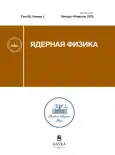Volume 88, Nº 1 (2025)
ЯДРА. Эксперимент
THE REVISION OF CUMULATIVE SPECTRA OF BETA PARTICLES FROM 235U, 239Pu AND 238U FISSION PRODUCTS BASED ON THE UPDATED MEASUREMENTS OF THE RATIO OF SPECTRA 235U/239Pu
Resumo
 5-9
5-9


NEW DATA ON PHOTONEUTRON REACTION CROSS SECTIONS FOR 68Zn
Resumo
 10–18
10–18


THE RESEARCH OF THE APPLICATION OF 3D PRINTING FOR THE MANUFACTURE OF A SCINTILLATION DETECTOR CASE
Resumo
 19–23
19–23


ЯДРА. Теория
NUCLEOSYNTHESIS OF TRANSURANIUM ELEMENTS IN THERMONUCLEAR EXPLOSIONS
Resumo
 24–32
24–32


ЭЛЕМЕНТАРНЫЕ ЧАСТИЦЫ И ПОЛЯ. Эксперимент
THE UNUSUAL EVENTS IN X-RAY EMULSION CHAMBER EXPERIMENTS
Resumo
 33–41
33–41


ANALYZING POWER MEASUREMENTS OF QUASI-ELASTIC PROTON-PROTON SCATTERING AT THE INTERMEDIATE ENERGIES AT THE NUCLOTRON INTERNAL TARGET
Resumo
 42–53
42–53


MEASUREMENT OF THE e+e− →π+π−2π0η CROSS SECTION BELOW √s = 2 GeV
Resumo
 54–63
54–63


ANALYSIS OF THE SEARCH RESULTS FOR PENTAQUARKS IN THE ZEUS EXPERIMENT
Resumo
 64-72
64-72


SENSITIVITY OF THE CP-VIOLATION PHASE MEASUREMENT IN THE LEPTON SECTOR IN THE P2O EXPERIMENT
Resumo
 73–80
73–80


OPTICAL SCHEME OF THE NEUTRINO CHANNEL WITH MAGNETIC HORNS AND DIPOLES AT THE U–70 ACCELERATOR COMPLEX
Resumo
 81–88
81–88


ЭЛЕМЕНТАРНЫЕ ЧАСТИЦЫ И ПОЛЯ. Теория
INFLUENCE OF INVERSE GLUON EMISSION ON FORWARD–BACKWARD ASYMMETRY IN DILEPTON PRODUCTION PROCESS AT LHC
Resumo
 89–101
89–101


PROCEEDINGS OF 74TH INTERNATIONAL CONFERENCE ON NUCLEAR PHYSICS “NUCLEUS-2024: FUNDAMENTAL PROBLEMS AND APPLICATIONS”, 1–5 JULY 2024, DUBNA, RUSSIA. Nuclei. Experiment
CORRELATION CHARACTERISTICS OF THE 20Ne(2+, 1.634 MeV) NUCLEUS, FORMED IN THE 19F(α, t)20Ne REACTION AT 𝐸α = 30.3 MeV
Resumo
 102–109
102–109


INVESTIGATION OF (γ, xn)-REACTIONS ON NATURAL IRIDIUM AT 55 MeV BREMSSTRAHLUNG END-POINT ENERGY
Resumo
 110–115
110–115


DETERMINATION OF EXCITATION ENERGY SPECTRUM OF 6Li IN THE n + 6Li REACTION
Resumo
 116–123
116–123


CURRENT STATE AND PROSPECTS OF USING IONIZING RADIATION SOURCES IN RUSSIA
Resumo
 124–136
124–136


PROCEEDINGS OF 74TH INTERNATIONAL CONFERENCE ON NUCLEAR PHYSICS “NUCLEUS-2024: FUNDAMENTAL PROBLEMS AND APPLICATIONS”, 1–5 JULY 2024, DUBNA, RUSSIA. Nuclei. Theory
EVOLUTION OF NEUTRON SHELL STRUCTURE OF N = 14, 16 ISOTONES
Resumo
 137–144
137–144


THEORETICAL STUDY OF THE TRANSFER REACTIONS IN THE D–D SYSTEM
Resumo
 145–150
145–150


MACHINE LEARNING IN THE PROBLEM OF NO CORE SHELL MODEL RESULT EXTRAPOLATIONS
Resumo
A method for extrapolating the results of variational calculations to the case of the infinite basis using an ensemble of artificial neural networks is proposed. Extrapolations of the no-core shell model results obtained with nucleon-nucleon interaction Daejeon16 for the ground state energies, as well as for the rootmean-square point-proton, point-neutron and point-nucleon (matter) radii of the 6Li and 6He nuclei, are performed.
 151–160
151–160


PROCEEDINGS OF 74TH INTERNATIONAL CONFERENCE ON NUCLEAR PHYSICS “NUCLEUS-2024: FUNDAMENTAL PROBLEMS AND APPLICATIONS”, 1–5 JULY 2024, DUBNA, RUSSIA. Elementary particles and fields. Experiment
POSITION-SENSITIVE CHERENKOV MONITOR OF HIGH-INTENSITY PROTON BEAMS
Resumo
 161–166
161–166











